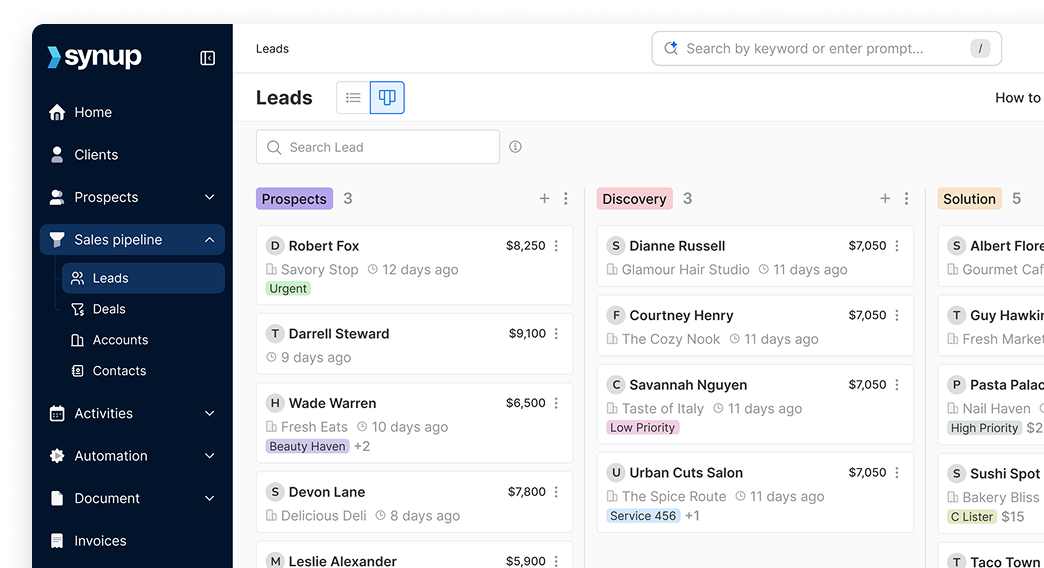Tips for Managing Multiple Local Listings Across Different Platforms
Get tips for managing local listings across different platforms in 2024. This guide will help you streamline your online presence, improve visibility, and engage with your customers better
Why Local Listings Matter
Let’s start with the basics. Local listings are online entries that provide key info about your business, like your name, address, phone number (NAP), hours, and what you offer. They show up on search engines, maps, and social media, so getting them right is essential.
When people search for products or services nearby, local listings are usually the first thing they see. Did you know that 46% of all Google searches are local? That’s huge!
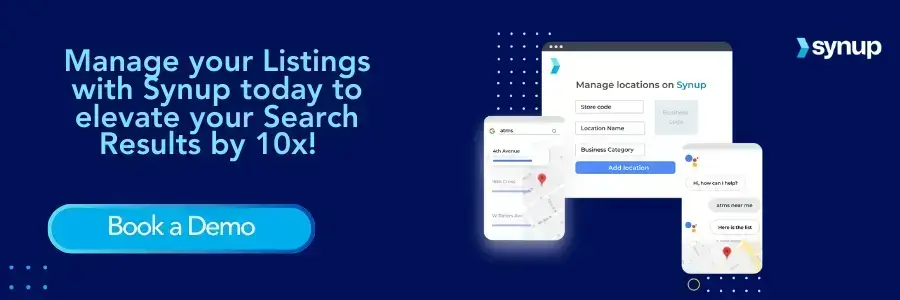
Reputation Management
Your online reputation is heavily influenced by the accuracy of your local listings. Inconsistent or outdated information can confuse customers and damage trust. Regularly monitoring and updating your listings helps maintain your credibility, which is important for attracting and retaining customers.
Consumer Behaviour
Local listings provide you with in-depth insights into customer behavior and preferences. By understanding how users interact with your listings, such as click-through rates and customer inquiries, you can tailor your marketing strategies to better meet their needs.
What does managing multiple listings across different locations looks like?
Managing multiple franchise locations can be a headache, especially when it comes to something as simple as updating business hours. You’ve got to log into different platforms, Google, Yelp, social media for each location, and that takes up way more time than it should. With 10 locations, it’s easy to get caught up in repetitive tasks that eat away at your day.
Here are some ways on how you can go about managing your local listings across different platforms easily:
- A unified dashboard is a lifesaver when it comes to managing multiple listings. Instead of jumping from one platform to another, a centralized platform lets you oversee everything in one place.
- A key benefit of centralized management is the ability to make real-time updates. Whether it’s changing store hours, adding new services, or updating addresses, you can instantly push changes across all your listings with a few clicks. This ensures that your online presence is always up-to-date and accurate, which helps prevent customer confusion.
- Bulk management allows you to implement changes across all your locations at once. For instance, if you need to update holiday hours for 20 locations, you can do it in a single action rather than 20 individual updates. This not only saves you time but keeps your workflow efficient.
- Create templates for common updates like store closures, holiday hours, or seasonal offers. This way, whenever you need to make a similar update across multiple locations, you just apply the template rather than starting from scratch every time.
- Automate routine checks to catch any discrepancies in your listings. For example, set up an alert system that flags any inconsistencies between your website and your listings (e.g., mismatched hours or incorrect addresses). These systems can help you spot and fix errors before they impact your online visibility or customer experience.
- Once your listings are up and running, regular monitoring is key to maintaining their effectiveness. Monitoring helps ensure that your information stays accurate and that your performance is optimized for maximum reach and engagement.
- Use a tool that aggregates reviews from multiple platforms, so you can monitor them all in one place. Instead of visiting Google, Yelp, and Facebook individually, you get a full view of customer feedback in a single dashboard.
Now, all of this might not be practically possible for an individual to keep track of. Therefore, there are various tools that can help you to get there and make sure that you dont miss out on any of these steps.
Top Platforms to help manage your Local Listings across multiple platforms
1. Google My Business
Google My Business (GMB) is a game changer for local listing management. It helps you get noticed on Google Maps, where many potential customers are actively looking for services like yours. A well-optimized GMB profile not only helps set you apart from the crowd your online presence but also helps increase your credibility and visibility in the community.
Here are a few:
- Keep your business info accurate and updated, this is your first impression!
- Use high-quality images that showcase your offerings and draw customers in.
- Encourage happy customers to leave reviews and respond to them; it builds trust.
- Share updates, promotions, and events to keep your audience engaged.
- Stay responsive to customer questions, this shows you care
- Regularly check your performance metrics to refine your strategy.
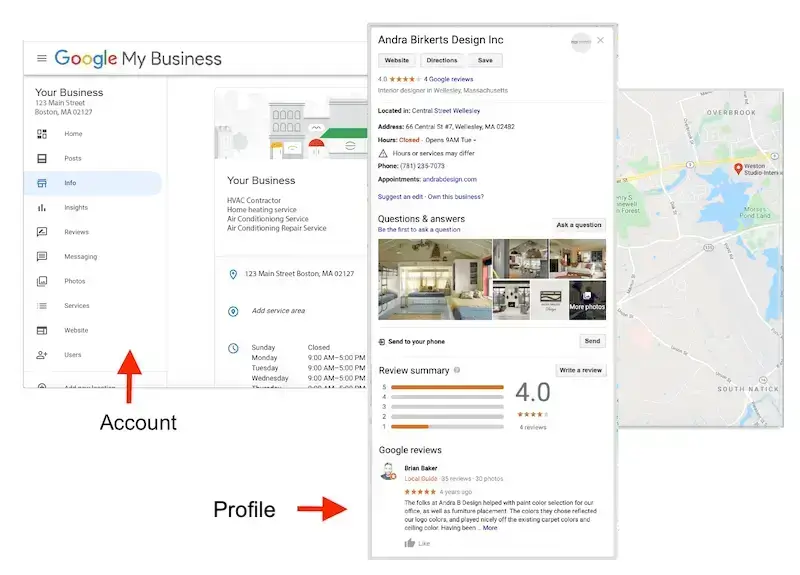
2. Synup
Synup helps you manage your Google My Business (GMB) profile, keeping all your local listings accurate and visible.It works as an add-on for your GMB profile. It’s built for agencies, keeping their everyday wants and needs in mind. With features like Listings Management, Reputation Management, Social Media Management, Citation Builder, Store Locator pages, and more, Synup gives you a complete suite of Local SEO tools to work with.
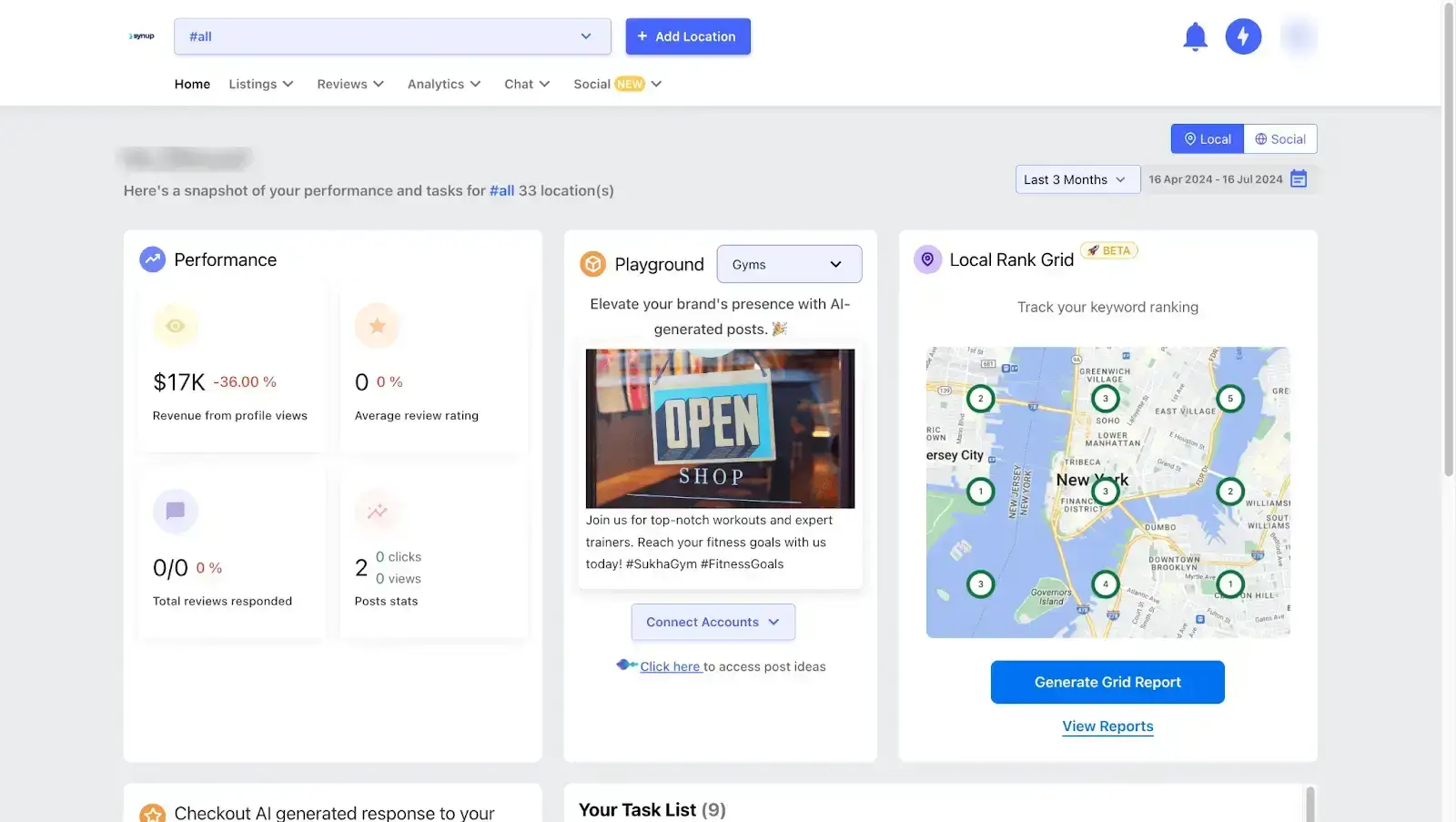
What does it offer?
- Access to over 60 directories, including Google My Business, Facebook, Yellow Pages, Bing, and more.
- Bulk creation, editing, publishing, and management of listings across multiple platforms.
- Automated listings updates with active synchronization.
- Voice search optimization to improve visibility in search results, especially for no-click searches.
- Natural Language Processing for sentiment analysis, offering insights into customer feedback.
- Response templates for quick replies to reviews.
- Smart response system that automatically replies to reviews based on sentiment, ratings, location, or keywords.
- Customizable landing pages featuring location information, reviews, business hours, photos/videos, and special services.
- Seamless AI integration for social media management.
- Campaign management tools for product promotion and customer engagement.
- Automation tools for scheduling posts, offers, and campaigns.
- Automatic campaign performance reports.
- In-depth campaign performance monitoring for informed decision-making.
3. Yext
Yext is a prominent player in the listing management industry, known for its extensive capabilities and robust local citation software. The platform offers accurate listing syncs with minimal bugs, leveraging its vast network and advanced features. However, some users have reported challenges with customer support accessibility following the company's rapid growth.
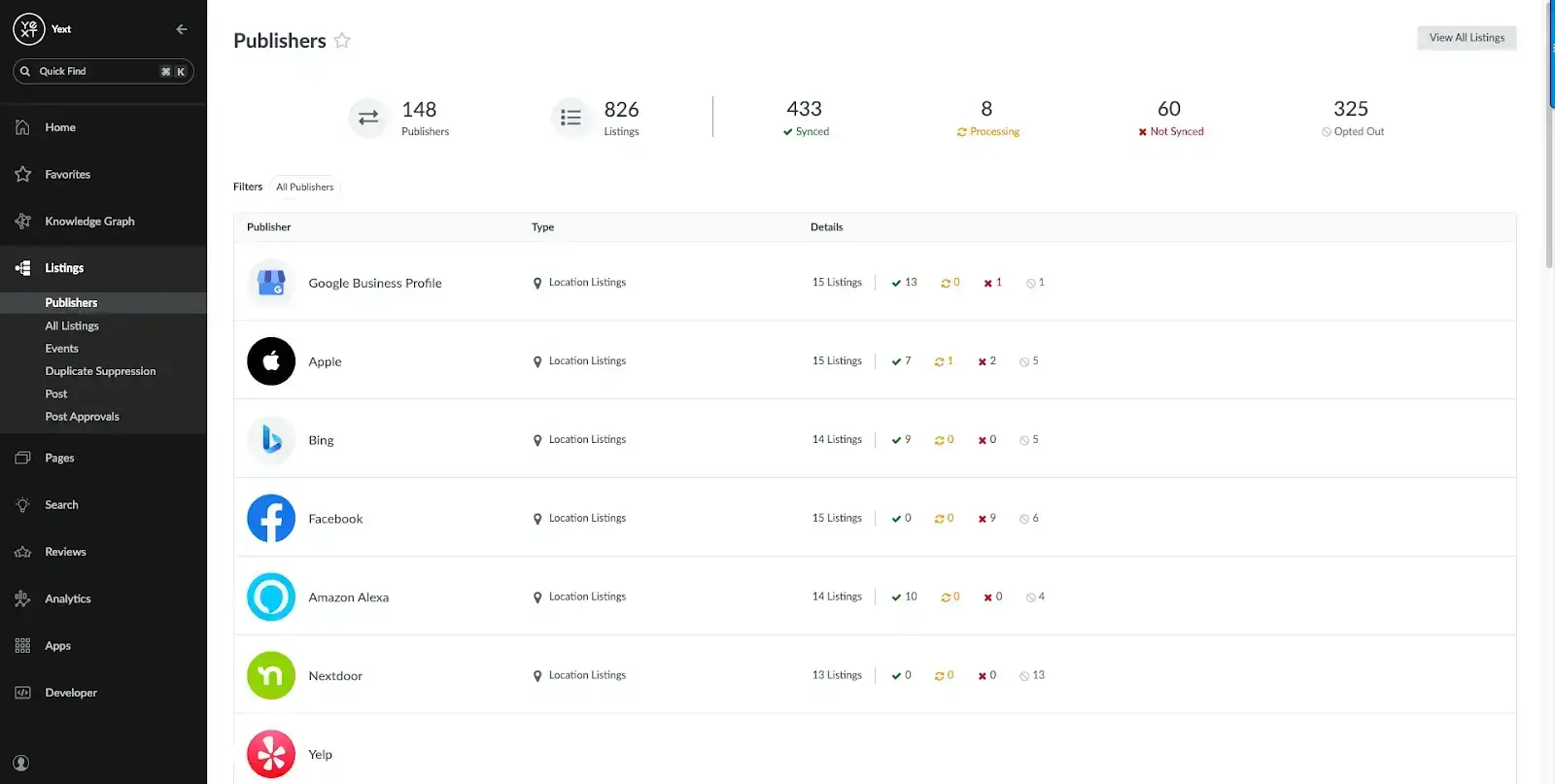
How does it help?
- Access to over 200 third-party publishers for broad business data distribution
- Dual-sync direct API integrations for seamless updates of NAP, images, and custom fields
- Consolidated Listings Analytics for easy data filtering and analysis
- Real-time update architecture ensuring rapid data delivery across publishers
- Ability to deactivate over 100 duplicate listings to maintain authoritative information
- Incorporation of suggested edits from Google, Facebook, and users for data accuracy
- Performance insights comparing your listings against local competition
- Social posting capabilities across platforms like Facebook and Google
- Comprehensive tracking of listing statuses, error alerts, and custom controls
- Automated Listings Verifier for field-by-field accuracy checks
However, it’s pricing may change from time to time leaving customers unsure of whether they should opt for the service or not. They also are one of the most expensive platforms out there.
4. BrightLocal
BrightLocal is a top-notch local marketing software with an attractive user interface and excellent analytics and reporting features. Their listing management is manual, which makes citation submissions affordable but can be pricey for updating listings. Their local analytics tools, like the keyword tracker and Grid ranker, provide detailed insights into local performance.
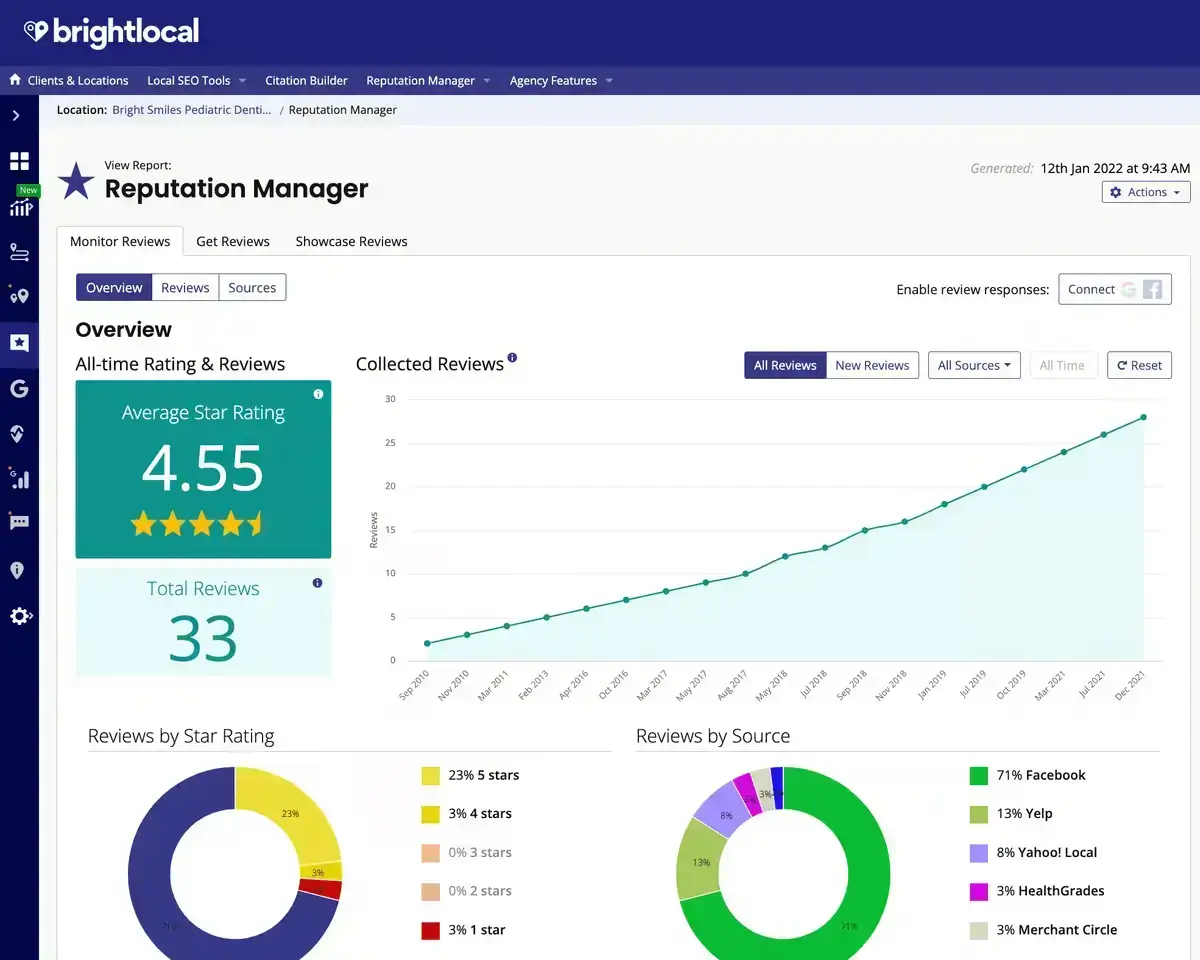
What does it offer?
- Dedicated team to create and optimize listings on these top sites.
- Permanent citation ownership with no recurring fees.
- Real-time updates for major platforms such as Google, Apple Maps, Facebook, and Bing.
- Easy process for setting up and maintaining accurate listings.
- Authority Layer for key foundational citations.
- Engagement Layer for high-visibility platforms.
- Mix of expert management and API-driven updates.
- Focus on authoritative sites to maximize SEO impact.
However, The tool's partially manual citation process can slow down updates, making changes and updates more time-consuming and potentially pricier compared to more automated options.
Some additional tips
✅Start by figuring out what keywords and phrases your potential customers are using to find services or products like yours. Tools like Google Keyword Planner, Ahrefs, or SEMrush are great for uncovering local keywords with decent search volume.
✅Once you’ve got your keywords, weave them into your business listings naturally. Here’s how:
- If it fits, add relevant keywords to your business name (e.g., “Joe's Pizza - New York’s Best Pizzeria”).
- Use those keywords in your business description to highlight what makes you unique. Aim for a compelling, informative description that reads well.
- Clearly outline what you offer, using keywords where it makes sense to improve your visibility in local search results.
✅ When setting up your listings on platforms like Google My Business, it’s crucial to pick the right primary and secondary categories for your business. Here’s how:
- Primary Category: This should reflect your main service or product. If you run a bakery, your primary category should be “Bakery,” not something generic like “Restaurant.”
- Secondary Categories: These can capture other relevant aspects of your business. For instance, if you also offer catering services, you could add “Caterer” as a secondary category.
✅Picking the right categories helps you show up in local searches. It allows search engines to understand your business better, leading to more relevant traffic. Customers are more likely to find you if your categories match their search intent.
✅Make sure to claim and verify your business on all relevant platforms (like Google My Business, Yelp, Bing Places, etc.). This adds credibility and gives you control over your info.
✅Keep your business Name, Address, and Phone number (NAP) consistent across all listings. Any inconsistencies can confuse search engines and hurt your rankings.
✅Actively seek reviews from your customers, as they play a big role in local search rankings. Responding to reviews shows you’re engaged and helps build customer trust.
✅Add images of your business, products, or services to make your listing more appealing. Listings with images tend to perform better in searches.
✅Regularly review and update your listings with any changes in hours, services, or contact info. Keeping everything current helps maintain accuracy and improves user experience.
Summing it up:
Optimizing your local listings is a game-changer for boosting your online visibility and attracting the right customers to your business. By incorporating the relevant keywords, choosing the right categories, and keeping your information consistent across platforms, you are all set to make it in the top local SERPs.
That’s where Synup steps in.
With its powerful listing management features, Synup makes it easy to optimize and manage your business information across various platforms. You can claim and verify your listings with ease, ensure your NAP details are spot on, and enhance your visibility with targeted keywords. Plus, Synup lets you monitor reviews and engage with your customers directly, helping you build trust and foster loyalty.
So, take control of your local SEO with Synup and watch as it helps you draw in more relevant traffic, connect with your audience, and grow your business. It’s all about being found by the right people, and Synup is here to help you make that happen.

Tips for Managing Multiple Local Listings Across Different Platforms: FAQs
- Local SEO for multiple locations
For local SEO across multiple locations, set up individual Google My Business listings for each spot with tailored content and localized keywords. Keep your Name, Address, and Phone number (NAP) consistent, and optimize each listing with relevant categories and local content to boost visibility in search results.
- How to best manage your local listings across multiple platforms
To manage your local listings across multiple platforms effectively, use a centralized tool like Synup to keep your information consistent and up-to-date. Regularly monitor and update your listings, respond to reviews, and ensure your NAP details are accurate to enhance visibility and build customer trust.
- Best Practices for Using Google My Business for Multi-Location Businesses
For multi-location businesses, it’s crucial to tailor each Google My Business listing to its specific area by using local keywords and relevant images. Make sure to frequently check and respond to customer inquiries and reviews, and utilize location-specific posts to keep your audience engaged and informed about each branch.




